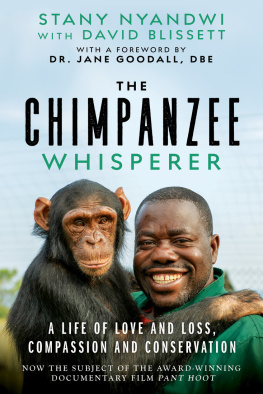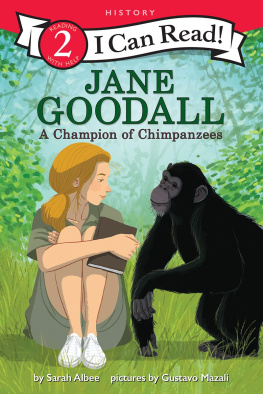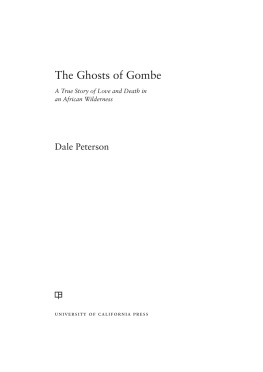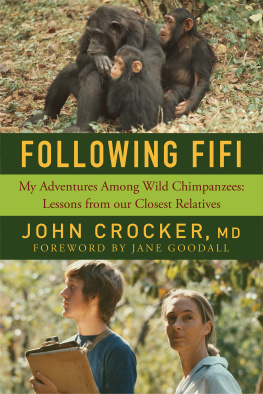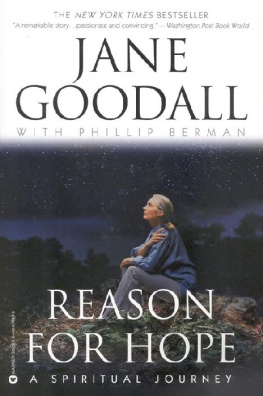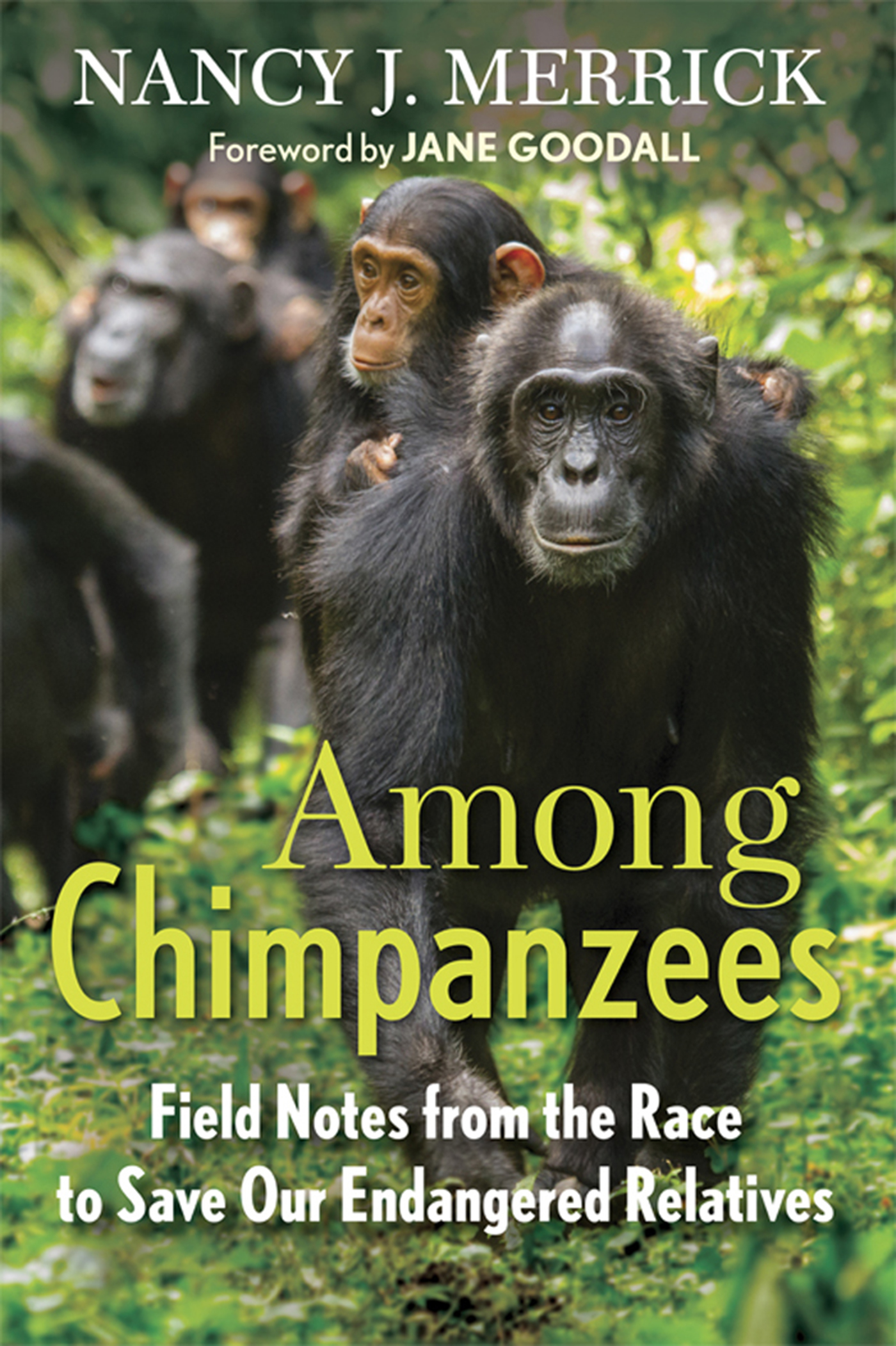
Likely historic distribution. From Tess Lemon, Chimpanzees (London: Whitlet, 1994).
Current conservation areas. From A.P.E.S. Portal (http://apesportal.eva.mpg.de).
Speculative future distribution if survival only in some national parks.
Among
Chimpanzees
Field Notes from the Race to
Save Our Endangered Relatives
NANCY J. MERRICK
BEACON PRESS, BOSTON
This book is written on behalf of the amazing chimpanzeesand in honor of those who have loved them as much as I have.
It is especially dedicated to my friend Bandit, an uncommonly intelligent chimp whose life made mine so much richer.
To Jane, who fights every day on behalf of chimps.
And to David, who fights for peace and humanity.

Treat the earth well; it was not given to you by your parents; it was loaned to you by your children.
KIKUYU PROVERB, KENYA
Beacon Press
Boston, Massachusetts
www.beacon.org
Beacon Press books
are published under the auspices of
the Unitarian Universalist Association of Congregations.
2014 by Nancy J. Merrick
All rights reserved
Printed in the United States of America
Foreword 2014 by Jane Goodall
17 16 15 14 8 7 6 5 4 3 2 1
This book is printed on acid-free paper that meets the uncoated paper ANSI/NISO specifications for permanence as revised in 1992.
Text design and composition by Wilsted & Taylor Publishing Services
Map of Equatorial Africa showing chimpanzee habitat by Beth D. Merrick.
LIBRARY OF CONGRESS CATALOGING-IN-PUBLICATION DATA
Merrick, Nancy J.
Among chimpanzees : field notes from the race to save our endangered relatives / Nancy J. Merrick.
pages cm
Includes bibliographical references and index.
ISBN 978-0-8070-8490-8 (hardcover : alk. paper) ISBN 978-0-8070-8491-5 (ebook) 1. ChimpanzeesConservationAfrica, East 2. Wildlife conservationistsAfrica, East. 3. PrimatologistsAfrica, East. I. Title.
QL737.P96M47 2014 |
599.885dc23 | 2013045229 |
CONTENTS
FOREWORD
In every persons life, there are pivotal moments, events that alter our perspectives and leave us changed forever. One of those moments in my life came in 1986, when I attended a conference on chimpanzees that brought together chimp researchers from all over the world. One after another, as each of us shared the stories of the chimpanzees we were studying, we were shocked to recognize a terrible commonality: in every study site, there was habitat destructionwhether due to human population growth, logging, mining, or cattle grazing. Chimpanzees were being caught in snares, losing their arms or legs or even their lives. Some were hunted for the live-animal trade, the mothers shot in order to steal their infants for medical research or for entertainment or to become pets. We heard about the bushmeat tradethe commercial hunting of wild animals, including chimpanzeesvery different from the subsistence hunting that had enabled forest people to live in harmony with their world for hundreds and hundreds of years.
During one afternoon session, we also heard about the sometimes horrible conditions some captive chimpanzees face. We saw secretly filmed footage of chimpanzees imprisoned in the sterile, steel-barred five-by-five-foot cells of a medical-research lab. The images chilled my soul and filled me with sadnessand anger. I arrived at the conference as a scientist, having realized my childhood dream of living with animals in Africa and writing books about themand even acquiring a PhD along the way, thanks to Louis Leakey. But I left as an activist, knowing that I would have to leave the forest and the chimpanzees I loved to do my bit, to do everything I could to try to save them. I have not spent more than three weeks consecutively in any one place since; instead, I travel constantly on their behalf.
The chimpanzees and the other great apes face an uncertain future. Chimpanzees are already extinct in four of their original twenty-five range countries and nearly so in ten more, and it is estimated that their populations could decline by another 80 percent in the next thirty to forty years.
Local people living in poverty are cutting down more trees to try to eke out a livelihood for their families, even as over-farming depletes nourishment from the soil. Foreign companies acquire land for logging or mining concessions or for intensive farming, securing it from government officials who are often corrupt. And as humans encroach ever deeper into the forest, so the danger of passing human diseases to the apes increases, for they are so like us biologically that they can catch our infectious diseases. And we can catch theirs.
I have seen the desperate poverty of so many of the people living around wilderness areas. We cannot hope to save the chimpanzeesor any other wildlifeif we do not help the people improve their lives. We must fight poverty on the one hand, greed and corruption on the other. And above all, we must try to educate young people to be better stewards of this planet than we have been. We also need more and more people to learn about the problems, to commit themselves to doing their best to help, and to become powerful voices for the great apes. Otherwise, our grandchildren may know a world where the last of the great apes live in zoos, or small forest patches, with little hope of long-term survival.

One of the aspects of my life at the Gombe Stream Research Center I loved was working with the students who came to learn about the chimpanzees and to help collect data for their PhDs or for our long-term study. Many of them have gone on to become respected scientists, doctors, teachers. One of them was Nancy.
I remember Nancy from the days when I taught human biology at Stanford University, and I remember how pleased I was when she was picked out of many applicants to join our team. Nancy went on to become a doctorand an excellent one, I am told. I would have expected no less. But she did not turn her back on the chimpanzees. Indeed, more than very many of my ex-students, she has risen to the challenge. I have been amazed and delighted by the way she has flung herself into learning ever more about the problems apes and people face in Africa, and by her determination to do all she can to helpeven to the extent of involving her family.
Nancy has also been a great supporter of Roots & Shoots, the program for young people I began in Tanzania in 1991. Roots & Shoots started with twelve high school students on my veranda in Dar es Salaam, but it now has members of all ages, from preschool through the university level, in more than 120 countriesand growing. There are groups right across Tanzania, and it is expanding in other African countries and throughout the world. Its recent expansion across mainland China means that these youth are now a vital part of our growing global family of young people who are learning, through service projects, to make the world a better place for people, other animals, and the environment we all share.
Roots & Shoots is creating leaders for tomorrowyoung people who communicate with each other, who understand that despite differences in culture and skin color, the same human heart beats within. In this way, we are trying to build a better world for tomorrow, based on understanding, love, compassion, and respect for all living things. Nancy started one of the first groups in California and has been involved ever since.



